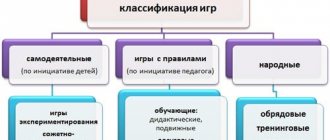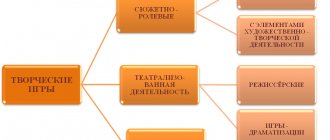Forms of organizing the labor activity of preschool children.
The choice of one form or another of organizing children’s work depends primarily on:
1) age and psychophysiological capabilities of children;
2) the level of work experience of children;
3) specific educational tasks set by the teacher organizing work activities;
4) content of work.
WORK ORDER - assigning a specific task to a child, which he must complete alone or with one of his peers. To assign means to oblige the child to do some kind of work related to both self-service and work for the team.
Peculiarities:
- they always come from an adult, they contain a clear focus on obtaining a result, the task is specifically defined;
- this is the simplest form of organizing the work activity of preschool children;
- have a special educational significance in working with children of primary preschool age, they enable the teacher to distinguish between play and work;
- they contain an element of demand, with the help of which the baby learns to act purposefully, to realize that he is fulfilling an adult’s task;
- helps the teacher monitor the correctness of the work, the presence of labor skills, the child’s attitude towards the assigned task, the ability to complete the work, provide ample opportunities for individual work with children, enable educators to routinely, systematically involve children in feasible work, create in group business atmosphere.
The assignments are varied in difficulty (simple, complex), nature of execution (individual or joint), time of execution (short-term, episodic, long-term).
Content:
- assignments for children of younger groups are predominantly individual in nature: at the request of the teacher, put forgotten shoes in the closet, pick up a dropped item, put it in its place, help take toys out to the area, collect them before leaving for a walk, distribute pencils for drawing, sweep sand from a bench and etc.;
- in the middle group, children are given instructions to water indoor plants, arrange soft toys correctly, wash soap dishes, put them in place, feed the fish, distribute boards for modeling, sweep the veranda, straighten clothes in closets, close them, wipe off dust on the shelf and etc.;
- in older groups, the teacher involves children in carrying out a wide variety of tasks that are not part of the duties of those on duty; a special place is occupied by assignments - tasks the result of which is delayed in time (sowing, planting, washing doll clothes, bringing a postcard from home, a picture of a certain content, etc. .), assignments of a public nature are given (to help children of younger groups, kindergarten staff,)
DUTY is a form of organizing children’s work in which those on duty always perform work that has social significance and is necessary for the team.
Peculiarities:
- this is a more complex form of organizing children’s work compared to assignments, requiring greater independence;
- those on duty are placed under conditions of obligatory completion of the task, they cannot refuse it, do other work that is more interesting for them, or switch to a game;
- make it possible for children to develop a desire to work for the sake of others, to show a caring attitude towards their comrades, animals and plants, to develop the ability to help adults, to notice where help is needed.
In the practice of preschool institutions, several types of duty are used, which are being introduced gradually:
- duty in the canteen (2nd junior group),
— duty to prepare for classes (middle group).
- duty in a corner of nature (senior group).
COLLECTIVE WORK - a common labor activity that unites all the children of the group at once (cleaning a group room or area, setting up a vegetable garden, flower garden, picking vegetables or fruits, decorating a hall or group room for a holiday).
Conditions:
I. All children can be united only after they have acquired the necessary experience of working in a small team.
2. When organizing the collective work of children of the entire group, it is advisable to divide them into several units (up to 4), each of which is offered a common task.
3 the content of general work includes only those types of work, the skills of which children have a sufficiently good command of,
4. All children should be involved in work.
Peculiarity of work activity:
1. A distinctive feature of children’s work is its closeness to play. When performing a work task, children often switch to play - playing with water while washing, acting out work actions, etc. However, there are also some differences: labor has a clearly defined end result; the process of labor without achieving results is meaningless; labor occurs in real terms; in it, the replacement of some objects with others, the child acts with real objects, actually transforms them. Explain the differences between play and work using specific examples.
2. The work of children is educational in nature. Work satisfies the child’s need for self-affirmation, for knowledge of his own capabilities, and brings him closer to adults.
3. In the process of labor, children acquire labor skills and abilities. But these are not professional skills (like, for example, a turner or mechanic), but skills that help a child become independent of an adult, independent.
4. In the process of his labor, the child does not create socially significant material values.
5. The work of preschool children does not have constant material reward.
6. The child’s work is situational and optional; only the child’s developing moral character “suffers” from its absence, since many vital personality qualities are developed in work.
7. A special feature of child labor is that, despite the presence of all the structural components of the activity, they are still in the development stage and necessarily require the participation and assistance of an adult.
Thus, the work activity of a preschooler has a number of differences from the work of adults, but despite this it is very important for the comprehensive development of the child.
The goal of the entire system of labor education is the moral, psychological and practical preparation of children for conscientious work for the common benefit and the formation of the principles of hard work. In kindergarten, this goal is achieved in accordance with the age capabilities of the children, as well as the characteristics of their work activities.
Conditions for organizing child labor:
I. Systematic nature of child labor. Each type of work contributes to the comprehensive development of the individual, but at the same time allows you to solve your own specific problems. It is necessary to structure the pedagogical process in such a way as to ensure an even distribution of all types of work and the systematic participation of each child in them.
2. Gradual workload. The amount of workload affects the child’s attitude towards work. The unbearability of labor can only cause disgust towards it. But too little load does not give a feeling of “muscular joy” (E.A. Arkin), which also makes it difficult to cultivate a positive attitude towards work. To determine optimal loads, external signs of the child’s fatigue during work are recorded: changes in complexion, skin moisture are noted, pulse and breathing rates are determined before and after physical activity for 3 minutes. The response from the cardiovascular and respiratory systems indicates favorable permissible and unfavorable physical activity.
3. Selection of equipment for work. Work equipment must be comfortable and suitable for children. Well-selected equipment that has an attractive appearance, allows the child to complete the task carefully, get results, encourages him to be active, and makes him want to work. The equipment is placed so that it is convenient for children to take it, use it, put it in order and put it in place.
4. Creation of a working atmosphere in the group. The daily life of a child in kindergarten is filled with work activity. This requires work effort from the child, and from the teacher - constant attention to how carefully and timely his pupils carry out work tasks, what attitude they show towards things, order, and peers. The teacher should constantly remember his role as a group leader. When taking on any task, he certainly organizes the children to complete it. In this way he creates in the group an atmosphere of constant employment, constant striving for useful work.
Types of labor: self-service, household work, work in nature, manual labor.
General, joint, collective work.
If assignments and duties have become systematic, permanent forms of organizing work in a group and the children have achieved certain success, it becomes possible to move on to a more complex form - general, joint, collective work.
This form of organizing children’s work primarily contributes to solving the problems of moral education. Already acquired work skills and abilities are only consolidated, and learning new ones is carried out, as before, individually. The teacher cannot introduce into the content of general work something that the children do not yet know how to do. For example, if children do not have the ability to properly wash toys, this work cannot be included in general activities, since the teacher will not have the opportunity for individual training.
General, joint and especially collective work creates favorable conditions for children to develop the ability to coordinate their actions, help each other, establish a uniform pace of work, etc.
What unites common, joint and collective work is the socially oriented goal of children's activities. This means that the result of work is always beneficial for everyone. Cleaning a room, area, decorating a group room for a holiday, etc. - all this is needed not by just one of the labor participants, but by all of them.
Common work presupposes an organization of children in which, with a common goal, each child performs some part of the work independently. For example, the teacher invites the children to clean up the group room and distributes responsibilities: “Sasha and Seryozha, you will put the building material in boxes. Natasha and Lena, put clean dresses on the dolls. Dima, Olya and I will wipe down the chairs,” etc. After finishing the work, he draws the children’s attention to the fact that everyone worked well and this is the result - the room became clean and beautiful. With this form of organization of work, each child has his own area and is responsible only for himself. Even if the same task is given to two children, everyone still completes it separately.
Joint work involves the interaction of children, the dependence of each on the pace and quality of the work of others. The goal, as in common work, is the same. With this form of organization, distribute children into units. Each link has its own work task, and within the link the children work in a “chain”: one removes toys from the shelf and puts them on the table, another washes them, the third wipes them, the fourth puts them back on the shelf. The quality and speed of one child’s work affects the same performance of another. With this form of organization, the sense of responsibility for a common cause increases. Business relationships are established between the children. A break in the chain occurs if someone disrupts the overall pace of work. And then children begin to independently regulate interaction.
Finally, collective can be called a form of labor organization in which children, along with labor ones, also solve moral problems: they agree on the division of labor, help each other if necessary, and “fear” for the quality of common, joint work. At the same time, the teacher plans in advance situations that will “provoke” children to establish relationships. He does not allow random combinations of children, but thinks through them (who to put Zina, who likes to be distracted, next to to work with; what task is best to give to Yura - he does not know how to work quickly, although he does everything efficiently; Kolya needs to be taught the ability and desire to help others; who should be entrusted with a relatively new area of work for children, etc.). The collective form is called collective because it contributes to the purposeful education of collective relationships.
So, not every common and not even every joint work is collective. But every collective work is common and joint.
Common work is possible already in the middle group of a preschool institution, joint and collective work - in high school and preparatory school.
Maintaining children's interest in collective work is facilitated by conscious acceptance of its motive and purpose. Traditionally, collective work is organized once a week. As a rule, this is cleaning a group room or working in nature. The goal statement is always the same - let’s clean up the group so that it’s clean and beautiful. The goal itself, of course, is worthy, but children get used to it, and it loses its attractiveness for them.
It should be emphasized that the allocation of a socially significant goal of labor for a certain period of time does not exclude either other content or other forms of organization. Children continue to be on duty, run errands, and learn work skills individually.
THAT. The work activities of preschoolers are organized in different forms. When distributing work, the teacher must take into account the individual characteristics of the children, the feasibility of the work performed, and at the end be sure to summarize and give an assessment.
Tasks of labor education of preschool children:
I. Fostering a positive attitude towards the work of adults, the desire to provide them with all possible assistance.
2. Formation of labor skills and their further improvement, gradual expansion of the content of work activity.
3. Raising positive personal qualities in children: habits of work effort, responsibility, caring, thrift, readiness to take part in work.
4. Formation of skills for organizing your own and general work.
5. Nurturing positive relationships between children in the process of work - the ability to work cooperatively and amicably in a team, to help each other, to kindly evaluate the work of peers, to make comments and give advice in the correct form.
The work of adults creates material and cultural values, is socially useful, and is recognized by people as a necessity and a need. The value of child labor lies in its educational value.
Duty roster . Duty involves the work of one or more children in the interests of the entire group. On duty, to a greater extent than on assignment, the social orientation of work, the real, practical care of several (one) children for others are highlighted, therefore this form contributes to the development of responsibility, a humane, caring attitude towards people and nature.
In preschool practice, duties in the canteen (from the 2nd half of the year, 2nd grade), in the corner of nature (older grade), and in preparation for classes (from the middle grade) have already become traditional.
Duty raises work activity to a higher level; it contributes to the development of social skills. While on duty, children learn to be organized, to take care of their comrades, and develop their work skills. A desire to do quality work and respect for the work of others is formed.
Methodology of organization : Children are assigned to duty one by one; it is best to appoint those on duty in the evening. The attendants must have their own uniform, and all children must go through all types of duty. The group sets up a duty board (it can be designed in different ways, depending on the imagination and skills of the teacher and parents), which should be understandable to the children, so that everyone knows about their responsibilities.
The duration of duty varies depending on the type of work, the age of the children, and the educational purpose. This can be a one-time duty (for one lesson), a day duty, i.e. during the day, duty in the dining room or in a corner of nature, 2-3 days (in rare cases). At the end of duty, it is useful to discuss with the children the quality of the work performed. The discussion can be carried out either only with those on duty, or in the presence and participation of all children. Such discussions are useful when introducing a new type of duty, as well as in cases where children perform their duties in a particularly interesting way. If any mistakes were made, it is more advisable to discuss this only with those on duty.
Dining room duty: At first, the teacher is “on duty” with two children and gives each one only one assignment, for example, Misha suggests placing the bread bins on those two tables, and Yulia on these. Then the task becomes more complicated: one child must place bread bins on all tables, and the other must arrange spoons. And finally, one child places everything that is needed on the tables: bread bins, napkins, cups, and arranges cutlery. And only after learning all this, children master the ability to coordinate their actions, negotiate, and distribute responsibilities independently. It is difficult to “link” each of the described stages of working with children to a specific age - it all depends on the level of development of children’s skills in joint activities, work skills, as well as the systematic nature of this work in their practice. But it is important to follow this sequence and promptly transfer children from one level of difficulty to another.
The teacher pays attention to the pace and quality of work. He especially appreciates manifestations of creativity, the child’s desire to bring joy to other children through his work. Sometimes a teacher or nanny tells those on duty how to show attention to a friend (“Today is Lyuda’s birthday, give her this beautiful cup”, “Let’s think about how we will make the children happy today - will we put flowers or lay out new napkins?”, “Let’s do it today?” Let’s arrange the tables differently so that everyone can see each other”, etc.); encourages the desire of those on duty to come up with something interesting and enjoyable for everyone.
Being on duty to prepare for classes requires concentration. Since the content of this duty is not as constant as the duty in the dining room, children should be helped and reminded of what should be on the tables when drawing with pencils, paints, modeling, designing. When the work is completed, the teacher asks those on duty to check if everything is in place.
Duty in a corner of nature should be organized so that children feel responsible for living objects throughout the day. If they complete all the tasks (feed the fish, water the flowers, clean the cage, etc.) in the morning, then later they will no longer need to pay attention to living beings and plants. Therefore, it is better for the teacher to help the children distribute responsibilities throughout the day: the fish can be fed in the morning, and the plants can be watered later. In addition, the person on duty must understand that he needs to “talk” to the parrot, the fish, and the plants. After all, they are alive and attention and kind words are important to them. This way, preschoolers will develop a need to take care of nature and a sense of responsibility for its preservation.
Sometimes educators get carried away by this form of work organization and unreasonably expand its types. For example, they arrange duty in the locker room, in the bedroom in preparation for going out for a walk, etc. This should not be done. This kind of activity turns into control of some children over the behavior of others. The moral development of preschoolers is harmed, and the main meaning of duty is lost - caring for others.
Means of labor education for preschool children . Labor education of preschoolers is carried out using a number of means: children’s own labor activity, familiarization with the work of adults, and artistic means.
1. Children’s own labor activity is a necessary means of labor education, because you can't learn anything without doing it. Labor activity is the leading means of labor education. Children learn specific work skills and abilities, achieve results, and satisfy their need for real inclusion in the world of adults. With the help of this tool, applied and practical problems of labor education are solved.
2. Familiarization with the work of adults. This tool will expand the child’s understanding of the content of human activity, the social significance of work, and the attitude towards work.
The educator can use the tool in question as a role model, a model that the child will follow. Familiarization with the work of adults is aimed at solving the intellectual and moral problems of labor education
3. Artistic media. The role of artistic means in the labor education of preschoolers is unique. You cannot teach a person to work by listening to music, a story, a fairy tale, or looking at a picture about work. But with the help of artistic means, it is possible to arouse in children an interest in work, a desire to be like those who work, to understand the importance and social significance of people’s work.
When working with children every day, the teacher uses:
- fiction : (proverbs and sayings, fairy tales, encyclopedic literature) with the help of fiction, several important teaching and educational tasks are solved at once: children learn about different professions, an interest in the activities of an adult is formed, an attitude towards it, but this is possible under the condition , if the teacher himself is an example for children and knows how to combine reading works of fiction with organizing the children’s own work activities.
New trends in labor education methods
Economic, social, environmental conditions determine the constant improvement of labor training and education methods: the emergence of new technologies, the introduction of the latest forms, methods, and techniques. They are based on the principle of variability.
While maintaining the unity of state requirements and their typical nature, labor education programs are drawn up taking into account the composition of those being educated, their age, regional characteristics, and traditions. This opens up opportunities for reducing the use of reproductive methods and increasing the proportion of research and creative forms of work. Inclusion in the labor sphere is carried out taking into account the physiological characteristics , psychological and social readiness of children, taking into account interests and inclinations.
Conditions for successful educational activities
When upbringing, the order of actions, the distribution of responsibilities in the team, the appointment of those responsible, and the availability of forms for summing up are of particular importance. Practical demonstration, training in the main methods, techniques, and compliance with safety are important. It is necessary to use incentives and, if necessary, punishment and censure. Public recognition of work results and approval by adults play an important role.
?
The main condition for success is the inclusion of the child in activities that are feasible for his age and physical capabilities. If it is organized correctly, it will contribute to the formation of the necessary moral qualities: hard work, accuracy, discipline, diligence, perseverance.
Labor becomes educational under several conditions:
- It must be significant and socially useful. This is the only way to realize the significance of the work. Understanding that it brings benefits to people gives additional motivation for work activity;
- The result should be something useful, of value for the team, for oneself and for adults. If the child does not see results, there is not much benefit from the work, the desire to work may disappear;
- Work must be collective. This is the implementation of assigned tasks together, capable of uniting with a common goal. It provides an opportunity to gain experience of interaction, mutual assistance, and solidarity;
- He must be proactive, preferably creative, various forms of self-government and self-organization must be used;
- Labor must be feasible, if possible connected with educational or other educational activities, it cannot be coercion, and punishing a child with it is unacceptable;
- You need to demand not just that the assigned task be completed, but that it be completed carefully and conscientiously.
Topics of labor education events in schools and kindergartens
Only if these conditions are met can labor be considered a real means of shaping the personality of a new generation.
We recommend “Problems of labor education of preschool children.”






